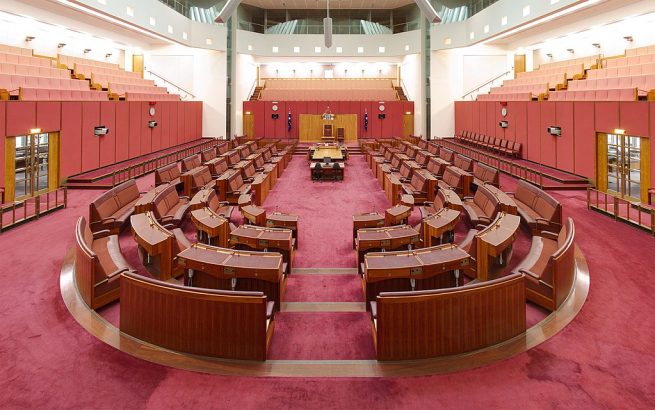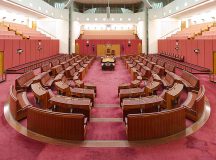Philip Mendes examines the conclusions of an inquiry held by the Australian Parliamentary Joint Committee on Human Rights, detailing four principal manifestations of Antisemitism in Australian universities.
The Australian Parliament has now completed two inquiries into antisemitism at Australian universities. The first inquiry, held by the Senate (Upper House) Legal and Constitutional Affairs Legislation Committee, reported in October 2024 (The Senate 2024). I previously analysed the findings and outcome of that inquiry in Fathom.
The second inquiry, held by the Parliamentary Joint Committee on Human Rights, reported in February 2025 (PJCHR 2025a). That inquiry, chaired by Josh Burns, the Labor Party Member for McNamara, received 49 written submissions, added to the 669 written submissions received by the first inquiry, and conducted four days of public hearings.
The inquiry reported evidence of a ‘disturbing prevalence of antisemitism that has left Jewish students and staff feeling unsafe, hiding their identity on campus and even avoiding campus all together’. It specifically castigated some university vice-chancellors for failing to act to prevent or censor ‘brazen incidents of antisemitism’ (p.ix).
The inquiry emphasised ‘the importance of universities listening to the lived experiences of Jewish students and staff’. It argued that best practice involved ‘pro-active engagement with the Jewish community’, and responses guided by those ‘lived experiences’. It concluded that ‘the current situation of Jewish students and staff feeling unsafe is unacceptable’ (p.ix).
Key recommendations of the inquiry included adoption of a specific definition of antisemitism, more formal engagement by university leaders with Jewish students and staff and accountability for the outcomes of that engagement, the establishment of antisemitism training for staff, and streamlining complaints processes to enable student reporting. Overall, the inquiry urged universities to ‘recognize their responsibility’ to actively reject manifestations of anti-Semitic ‘vilification and bigotry’ (p.x).
In summary, the two parliamentary inquiries have documented a large rise in antisemitic harassment within Australian universities, and an associated failure by many universities to take effective action to combat antisemitism, either on the general grounds of rejecting racism, or more specifically upholding their duty of care to protect the wellbeing of staff and students who happen to be Jewish.
Drawing on the findings of these two inquiries and similar findings reported from American campuses (Nelson 2025), it seems reasonable to define antisemitism on campus as involving hate speech that seeks to label, essentialise, and demonise Jews to exclude them from public discourse and erode their citizenship rights (i.e. make them second class citizens). Indeed, responding to the second inquiry recommendations, the 39 members of Universities Australia adopted in late February a definition as follows:
Antisemitism is discrimination, prejudice, harassment, exclusion, vilification, intimidation or violence that impedes Jews’ ability to participate as equals in educational, political, religious, cultural, economic or social life. It can manifest in a range of ways including negative, dehumanising, or stereotypical narratives about Jews. Further, it includes hate speech, epithets, caricatures, stereotypes, tropes, Holocaust denial, and antisemitic symbols. Targeting Jews based on their Jewish identities alone is discriminatory and antisemitic.
Criticism of the policies and practices of the Israeli government or state is not in and of itself antisemitic. However, criticism of Israel can be antisemitic when it is grounded in harmful tropes, stereotypes or assumptions and when it calls for the elimination of the State of Israel or all Jews or when it holds Jewish individuals or communities responsible for Israel’s actions. It can be antisemitic to make assumptions about what Jewish individuals think based only on the fact that they are Jewish.
All peoples, including Jews, have the right to self-determination. For most, but not all Jewish Australians, Zionism is a core part of their Jewish identity. Substituting the word “Zionist’’ for ‘’Jew’’ does not eliminate the possibility of speech being antisemitic.” (Universities Australia 2025).
Principal forms of Antisemitism in Australian universities
There seem to be four principal manifestations of Antisemitism in Australian universities. One is generic statements urging the exclusion of Jews per se (but often disingenuously using Zionist as a code word for Jews) from campus. For example, a pro-Palestinian encampment at Monash University held a large sign stating ‘Zionists are not welcome on campus’ (Sakkal & Crowe 2024) which was interpreted as a discriminatory demand for Jewish staff and students to be expelled from the university (PJCHR 2025b, p.45). Two academic historians have highlighted the similar malevolent use of Zionist as a codeword for Jews by the Stalinist perpetrators of the early 1950s antisemitic show trials (i.e. the 1952 Slansky Trial in Czechoslovakia and the 1953 Doctors Plot in the Soviet Union) in an attempt to obscure the racist framework of these trials (Lanicek & Balint 2025).
A second form is the specific targeting of individual Jewish students or academics for racist attacks which is arguably informed by the global BDS campaign to boycott not only all Israeli academics, but also any Jewish supporters of Israel (Nelson 2025). This racist harassment often occurs online via petitions or social media statements from pro-racist advocacy groups demanding the exclusion of Jews from campus on the grounds that to be a Jew (or ‘Zionist’) automatically makes such persons evil oppressors.
A more public attack was the public invasion of Jewish Professor Steven Prawer’s laboratory at the University of Melbourne by a threatening, masked racist mob of students and some staff incensed by his leadership of an academic collaboration arrangement with the Hebrew University of Jerusalem. This attack was condemned forthrightly by the National Tertiary Education Union as an example of ‘intimidation and bullying’ that threatens the safety of academics and should not be permitted on university campuses (Gooding et al 2024, p.6). There have also been reports of Jewish students being forced to leave share properties by racist housemates (Cervini 2024).
A third more subtle form is the inclusion of antisemitic ‘content’ by academics in formal lectures or teaching notes or recommended reading or scholarly output that incites hatred against Jews (Winter 2024). A fourth form is the deliberate manipulation of standard university processes – involving recruitment, mentoring and promotion of like-minded academic staff and Doctoral students – to create a growing cohort and potentially intergenerational political movement of antisemitic academics. Nelson (2025) notes that in the USA many university departments act to ensure ideological uniformity by actively discriminating against alleged Zionists who apply for employment. He recommends that departments which fail to conform to minimal governance standards regarding the hiring of scholars on grounds of evidence-based merit rather than political beliefs should have their independence restricted.
Who are the antisemites in Australian universities?
Little if any contemporary research has been completed on this topic, and neither of the parliamentary inquiries directly interrogated or named the leading perpetrators. However, a prime source of academic-based antisemitism seems to be the fringe Left Overland Online site. That site has published multiple petitions and articles since October 2023 that combine fundamentalist anti-Zionism and racist antisemitism including a specific justification of the racist attack on Professor Prawer’s office (University of Melbourne Staff 2024). Some Australian universities are over-represented in those petitions, as reflected in large numbers of academic signatures including many senior academics at Level D or above. Other universities have few if any senior academics represented in these petitions.
Ideological motivations of antisemites
The ideological motivations of antisemites seem to be diverse, but there is no doubt that most antisemitism in Australian universities is linked to the Israeli-Palestinian conflict and recent events in Gaza. This is not to argue that all anti-Zionism is antisemitism, and indeed there is no reason in principle why anti-Zionists cannot be anti-racists and hence robust opponents of antisemitism. Nevertheless, there is a core minority of Palestine Solidarity activists, guided by the global pro-racist BDS movement, who essentialise not only all Israeli Jews, but also all Jews anywhere who identify with the State of Israel, as evil oppressors to be targeted and attacked as the tribal enemy.
This group use arguments based on victim-blaming assumptions that combine political anti-Zionism and anti-Jewish race hatred, spuriously confound a legitimate right to individual academic freedom in areas of demonstrated expertise and knowledge with a non-existent collective right to engage in hate speech, obsessively attack the International Holocaust Remembrance Association definition of antisemitism in a tactical attempt to divert attention from the antisemitism crisis, misuse spurious concepts such as ‘moral panic’ and the alleged ‘weaponising’ of Antisemitism in an attempt to reverse the status of perpetrators and victims, and fail to engage with the lived experience of Jews (Oderberg 2025) adversely affected by the four forms of racism discussed above.
Blaming the victim strategies
The most common blaming the victim approach was to pretend that antisemitism does not exist in universities, and instead is imagined or dishonestly invented by Jews for ulterior pro-Israel motives (See, for example, Submissions 41 and 49; also Berkon 2024; Reynolds 2024; Riemer 2024). An alternative even more extreme version of this argument was that challenging anti-Jewish racism would somehow create anti-Palestinian racism, and that, by implication, in this imagined universe Jewish students and staff are never victims of racism, but solely perpetrators (Submissions 24 and 48; see also JCA 2024; Peleg 2024; Tatour 2024).
The inquiry report noted the argument from some written submissions that ‘discomfort regarding engagement with the Israeli-Palestinian conflict may be incorrectly equated with antisemitism’ (PJCHR 2025a, p.4), and later cited two specific written submissions denying any significant antisemitic incidents on campus (pp.23-24). But these submissions provided no evidence of informed consultations with Jews affected by anti-Jewish racism to verify this prejudiced assumption. They also ignore major global evidence that forms of anti-Zionist fundamentalism and racist antisemitism have increasingly converged, and that there is ‘no longer a meaningful distinction between the two phenomema’ (Nelson 2025, p.6).
The associated application of the sociological term ‘moral panic’ (See Submission 48; also Peleg 2024; Reimer 2024) to deny the existence of the antisemitism crisis in Australian universities is arguably highly offensive. That term was coined by the sociologist Stanley Cohen (1972) to refer to the way that media reporting privileged some social problems over others (for example highlighting the abuse of younger children whilst ignoring the systemic neglect of older adolescents living in or leaving out-of-home care); and targeted individualistic interpretations of the causes of such problems that simplistically blamed particular groups that were labelled ‘folk devils’ (for example child protection workers or politically correct beliefs) rather than deep-seated structural or systemic inadequacies such as lack of housing or health and welfare support services. Its application to refer to the antisemitism crisis cynically implies that allegations of antisemitism in universities are fabricated, and that Jewish concerns about racism are unfairly granted greater recognition than the allegedly more deserving concerns of other minority groups.
Additionally, some commentary presented the conspiratorial allegation that Jews are ‘weaponising’ claims of antisemitism to silence criticism of Israel (Submission 49, see also Australian Greens 2025; Peleg 2024). This term arguably reflects an old racist assumption that Jews are manipulative liars who use their disproportionate power and influence to defend their narrow interests (Szego 2025). In contrast, that word has never been used to denigrate the concerns of other groups subjected to widespread racism in Australia such as African Australians or Chinese Australians, or particularly First Nation Australians.
An additional blaming the victim strategy is to demand that the voices of perpetrators rather than victims of antisemitism be privileged, or alternatively to imply that the main victims of antisemitism are in fact a tiny group of Jews who are actual political partners of the perpetrators. In my earlier analysis of the first parliamentary inquiry (Mendes 2024), I noted that seven Jewish anti-Zionist groups (the most notable being the oft-quoted Jewish Council of Australia/JCA) had presented ‘blaming the victim’ submissions. These Jewish groups, which seem to have internalised the anti-Jewish prejudices of wider sections of the Australian majority culture, insisted that antisemitism was almost solely generated by ultra-right Nazis and not associated with pro-Palestinian protests. Regardless, they argued, without any consultation with Jewish lived experience views, that it was an insignificant phenomenon compared to the allegedly larger forms of racism directed against other cultural and religious groups, and paradoxically insisted that the inquiry would increase rather than prevent antisemitism by reinforcing the perceived association of Australian Jews with the actions of the State of Israel (Mendes 2024).
Judging by questions and statements during the public hearings, most of the members of the Parliamentary inquiry committees seem to understand that the JCA are a small fringe group that are representative of less than one per cent of Australian Jews. The JCA adamantly refuses to acknowledge the key (pro-Palestinian) sources of antisemitism within universities, fail to distinguish individual incidents of antisemitism from examples of systemic and institutional antisemitism, argue that Palestinian national rights can only be advanced via an ethnocentric targeting of all pro-Israel Jews as evil oppressors, and have consistently opposed any actions by government, universities, or other civil society institutions to combat antisemitism (e.g. JCA 2024; 2025; Kaiser 2024). They are considered by most Australian Jews to be little more than a ‘front group’ for anti-Jewish interests performing a similar function to that played by the fringe Left Jewish Voice for Peace group in the USA (Nelson 2025). Yet, the progressive Australian Greens have consistently highlighted the JCA’s views, and bizarrely contended that the biggest threat of antisemitism comes not from the actual perpetrators of anti-Jewish racism, but rather from some pro-Israel Jewish students who have intolerantly (but not inaccurately) attacked the tiny group of JCA members as political allies of antisemites (PJCHR 2025b, p.30).
Finally, there are the repeated disingenuous attempts to discredit the widely accepted International Holocaust Remembrance Alliance (IHRA) definition of antisemitism. A number of submissions to the inquiry (see, for example, Submissions 18, 24, 34, 42 and 48 plus a dissenting report from the Australian Greens), insisted that the IHRA definition conflates anti-Zionism and antisemitism, and/or seeks to silence legitimate criticisms of Israel and undermine academic freedom (PJCHR 2025a, pp.46-47; 83-84).
To be sure, IHRA states that ‘denying the Jewish people their right to self-determination, e.g., by claiming that the existence of the State of Israel is a racist endeavour’ could be viewed as an example of contemporary antisemitism. But IHRA specifically adds that ‘criticism of Israel similar to that levelled against any other country cannot be regarded as antisemitic’. Johnson (2021) clarified that proportionate criticism of Israel could reasonably include sanctioning its ongoing military occupation of large sections of the West Bank, its building of Jewish settlements within those occupied lands, the unequal allocation of education, health care and other key services to the Arab population within Green Line Israel, and the degree of force used by the Israeli army to respond to Hamas military activities within the Gaza Strip.
Most of the other examples provided by IHRA have no link whatsoever to Israel or Zionism. Rather, they refer to manifestations of racial and violent antisemitism such as ideological and theological calls for the death of Jews, accusing Jews of holding world power, targeting Jews as collectively responsible for the actions of any Jewish individuals, and Holocaust denial (IHRA 2022).
None of this means that the IHRA definition is flawless, and should not be subject to qualification or revision for appropriate application within the specific Australian context. In fact, that is precisely what the Universities Australia statement cited above has effectively done. Conversely, those groups and individuals who demonise IHRA seem to be solely motivated by a desire to minimise or deny any concerns about antisemitism (Hirsh 2021) and hence to block the adoption of any effective framework and strategies for naming and combatting antisemitism (Nelson 2025).
Conclusion
Universities should ideally be free-ranging forums for the open expression of a diverse range of alternate and competing opinions. But these debates should be evidence-based, and not led by ‘instant experts’ who have no track record of scholarship or knowledge of antisemitism, and/or hold zealous binary views that belittle Jewish lived experiences of racism. It is also never legitimate to debate the validity of racist tropes such as whether or not Jews control the international media, finance, and politics, or whether Jews should be excluded from universities. These prejudices were hegemonic within Nazi Germany and other fascist-controlled European states in the early-mid 20th century and also within the ethnocentric Arab regimes that expelled their large Jewish populations in the early-mid 1950s, but should be considered beyond the pale in multicultural Australia. There should be zero tolerance for manifestations of racial hatred against Jews and any other vulnerable groups within Australian universities.
References
Australian Greens (2025) “Universities thinly veiled attempt to shut down criticism of Israel is nothing short of shameful”. Press Release, 26 February. https://greens.org.au/news/media-release/universities-thinly-veiled-attempt-shut-down-criticism-israel-nothing-short.
Berkon, Michelle (2024) “Inquiry into anti-semitism a Trojan Horse for the Israel lobby”. Pearls and Irritations, 29 August. https://johnmenadue.com/inquiry-into-anti-semitism-a-trojan-horse-for-the-israel-lobby/.
Cervini, Erica (2024) “The normalisation of antisemitism”. Eureka Street, 3 October. https://www.eurekastreet.com.au/the-normalisation-of-antisemitism.
Cohen, Stanley (1972) Folk devils and moral panics. Routledge. London. https://infodocks.wordpress.com/wp-content/uploads/2015/01/stanley_cohen_folk_devils_and_moral_panics.pdf
Gooding, Gabe, MacDonald, Terri, & McCarron, Kieran (2024). “Submission 17 to PJCHR inquiry”, 19 December. https://www.aph.gov.au/DocumentStore.ashx?id=14a34fa7-9014-4aa9-b2a3-44e334a59658&subId=775374.
Hirsh, David (2021) “It was the new phenomenon of Israel-focused antisemitism that required the new definition of antisemitism”. In Alan Johnson (ed.) In defence of the IHRA working definition of Antisemitism. Fathom. London, 15-26. https://fathomjournal.org/wp-content/uploads/2021/02/Fathom-eBook-In-Defence-of-the-IHRA-Working-Definition-of-Antisemitism.pdf.
International Holocaust Remembrance Alliance (2022) Working definition of antisemitism, https://www.holocaustremembrance.com/resources/working-definitions-charters/working-definition-antisemitism.
Jewish Council of Australia/JCA (2024) Report into Antisemitism at Australian universities. https://cdn.prod.website-files.com/6577c97315a9a61836d6f32d/6764e64fa2cb21d18f528e87_Report%20Antisemitism%20Universities.pdf.
JCA (2025) “Jewish Council of Australia slams universities’ adoption of dangerous, politicized and unworkable antisemitism definition”. Press release, 26 February. https://www.jewishcouncil.com.au/media/jewish-council-of-australia-slams-universities-adoption-of-dangerous-politicised-and-unworkable-antisemitism-definition.
Johnson, Alan (2021) “Introduction: Seeing the IHRA Plain”. In Alan Johnson (ed.) In defence of the IHRA working definition of Antisemitism. Fathom. London, 4-7. https://fathomjournal.org/wp-content/uploads/2021/02/Fathom-eBook-In-Defence-of-the-IHRA-Working-Definition-of-Antisemitism.pdf.
Kaiser, Max (2024). “Law and order crackdown won’t make Jewish community safer”. Crikey.com, 12 December. https://www.crikey.com.au/2024/12/12/antisemitism-police-crackdown-australian-jewish-community-synagogue-fire/.
Lanicek, Jan & Balint, Ruth (2025). “A new definition of antisemitism from Universities Australia is attracting criticism – two historians explain why”. The Conversation, 12 March. https://theconversation.com/a-new-definition-of-antisemitism-from-universities-australia-is-attracting-criticism-two-historians-explain-why-251252.
Mendes, Philip (2024) “Prejudice in the academy, an analysis of the parliamentary inquiry into Antisemitism at Australian universities”, Fathom, December, https://fathomjournal.org/prejudice-in-the-academy-an-analysis-of-the-parliamentary-inquiry-into-antisemitism-at-australian-universities/.
Nelson, Cary (2025) “Mindless: What happened to universities?”. The Jewish Quarterly. Melbourne. https://jewishquarterly.com/essay/2025/03/mindless.
Oderberg, Isabelle (2025). “Jews have lived experience: listen to our fear”. The Jewish Independent, 30 January. https://thejewishindependent.com.au/for-those-who-belittled-jews-for-feeling-scared-its-time-to-look-in-the-mirror.
Parliamentary Joint Committee on Human Rights (2025a) Inquiry into Antisemitism at Australian universities. Commonwealth of Australia. https://parlinfo.aph.gov.au/parlInfo/download/committees/reportjnt/RB000531/toc_pdf/InquiryintoantisemitismatAustralianuniversities.pdf.
PHCHR (2025b) Antisemitism at Australian universities inquiry Proof Committee Hansard, 22 January. https://parlinfo.aph.gov.au/parlInfo/download/committees/commjnt/28681/toc_pdf/Human%20Rights%20Joint%20Committee_2025_01_22_Official.pdf;fileType=application%2Fpdf#search=%22committees/commjnt/28681/0000%22.
Peleg, Noam (2024) “Australia is dismantling academic freedom in defense of Zionism”. Mondoweiss, 19 October. https://mondoweiss.net/2024/10/australia-is-dismantling-academic-freedom-in-defense-of-zionism/.
Reynolds, Henry (2024) “Endless onslaught: Would Israel’s Mordechai be attacked as anti-Semitic in Australia?” Pearls and Irritations, 10 December. https://johnmenadue.com/endless-onslaught-would-israels-mordechai-be-attacked-as-antisemitic-in-australia/.
Riemer, Nick (2024) “Sydney University and the anti-Semitic cake stall”. Michael West Media, 30 October. https://michaelwest.com.au/sydney-university-and-the-antisemitic-cake-stall/.
Sakkal, Paul, & Crowe, Alex (2024) “University orders removal of ‘Zionist not welcome’ signs as protests escalate”, Sydney Morning Herald, 8 May. https://www.smh.com.au/politics/federal/university-orders-removal-of-zionist-not-welcome-signs-as-protests-escalate-20240508-p5gr97.html.
Szego, Julie (2025) “Accusations of weaponising anti-Semitism aim to silence”. The Australian, 1 March. https://www.theaustralian.com.au/inquirer/accusations-of-weaponising-antisemitism-aim-to-silence/news-story/7c0e8e0caffa7e7cf78bba254e6a54e9.
Tatour, Lana (2024). “Censoring Palestine: human rights, academic freedom and the IHRA”. Australian Journal of Human Rights, 30 (1), 106-114. https://www.tandfonline.com/doi/full/10.1080/1323238X.2024.2385504.
The Senate Legal and Constitutional Affairs Legislation Committee (2024) Commission of Inquiry into Antisemitism at Australian Universities Bill 2024 (No.2). Commonwealth of Australia. https://www.aph.gov.au/Parliamentary_Business/Committees/Senate/Legal_and_Constitutional_Affairs/AntisemitismBill/Report.
Universities Australia (2025) “Statement on racism”, 27 February. https://universitiesaustralia.edu.au/media-item/statement-on-racism/.
University of Melbourne Concerned Staff (2024) UniMelb staff statement on the right of protest and academic freedoms. Overland online, 22 October. https://overland.org.au/2024/10/unimelb-staff-statement-on-the-right-of-protest-and-academic-freedoms/.
Winter, B. (2024) “Antisemitism in our hallowed halls”. Substack, 7 October. https://bronwyndrw.substack.com/p/antisemitism-in-our-hallowed-halls.
(I am grateful to a number of academic and community-based colleagues from varied ethnic and cultural backgrounds and diverse ideological perspectives whose valuable insights have informed this analysis)




































